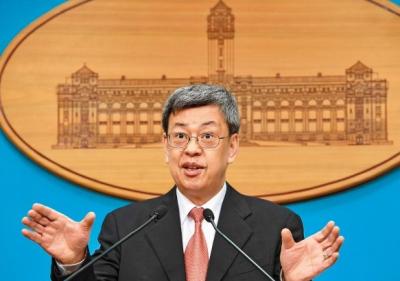China’s decision to send fighter jets across the median line of the Taiwan Strait on Sunday was intended to show Beijing’s dissatisfaction over warming Taiwan-US relations, a military expert said yesterday.
Two Chinese People’s Liberation Army Air Force J-11 fighter jets crossed the median line and entered Taiwan’s airspace at 11am on Sunday.
It was the first time since 1999 that the Chinese military had intentionally crossed the median line of the waterway, military sources said.
Chieh Chung (揭仲), a senior assistant research fellow at the National Policy Foundation, a think tank affiliated with the Chinese Nationalist Party (KMT), yesterday said that the operation reflected Beijing’s concern over more robust US support for Taiwan.
Foreign media have reported that the US will soon agree to Taiwan’s request to buy more than 60 F-16s, which would be the first US sale of new aircraft since 1992.
In addition, the two nations are holding a series of events this year in Taipei and Washington to mark the 40th anniversary of the Taiwan Relations Act, which serves as the basis of unofficial relations between Taiwan and the US.
These examples of warming ties have angered China and it responded by sending fighter jets over the median line, contravening a long-held understanding on the issue, Chieh said.
“It was meant to draw a red line, to tell the US not to ever cross it again,” he said.
A similar maneuver last occurred in 1999, when then-president Lee Teng-hui (李登輝) commented that Taiwan and China have a “special state-to-state” relationship.
That also angered Beijing, which later held exercises in the Taiwan Strait and sent military aircraft across the median line, Chieh said.
National Chung Cheng University Institute of Strategic and International Affairs assistant professor Lin Ying-yu (林穎佑) said that the median line issue also reflected a shift in the cross-strait military balance.
The air force had full control over the Taiwan Strait for decades, which made it impossible for Chinese jets to cross the line, but that has changed as Beijing has gained the upper hand in the cross-strait military balance, he said.
The concept of the median line was created in 1955 by US general Benjamin Davis Jr, commander of the US’ 13th Air Force, which was then based in Taipei, Chinese-language Military Link Magazine editor-in-chief Chen Wei-hao (陳維浩) said.
Since then, it has been very dangerous for Chinese aircraft to cross the line, because it would put them at a serious disadvantage as they would be targeted by Taiwanese fighters and radar, he said, adding that therefore, such intrusions rarely occurred.
Previous intrusions only lasted briefly and mainly occurred due to poor weather conditions, and on such occasions Chinese jets often returned to their side of the Taiwan Strait immediately after been warned by their Taiwanese counterparts, Chen said.
However, Sunday’s incident did not fall into that category and was a clear provocation, he said.
Chinese aircraft returned to China’s side of the median line only after receiving multiple radio warnings, the Ministry of National Defense said.
The intrusion triggered a 12-minute standoff between Taiwanese and Chinese warplanes, government officials said.

Several Chinese Nationalist Party (KMT) officials including Chairman Eric Chu (朱立倫) are to be summoned for questioning and then transferred to prosecutors for holding an illegal assembly in Taipei last night, the Taipei Police said today. Chu and two others hosted an illegal assembly and are to be requested to explain their actions, the Taipei City Police Department's Zhongzheng (中正) First Precinct said, referring to a protest held after Huang Lu Chin-ju (黃呂錦茹), KMT Taipei's chapter director, and several other KMT staffers were questioned for alleged signature forgery in recall petitions against Democratic Progressive Party (DPP) legislators. Taipei prosecutors had filed

Taiwan would welcome the return of Honduras as a diplomatic ally if its next president decides to make such a move, Minister of Foreign Affairs Lin Chia-lung (林佳龍) said yesterday. “Of course, we would welcome Honduras if they want to restore diplomatic ties with Taiwan after their elections,” Lin said at a meeting of the legislature’s Foreign Affairs and National Defense Committee, when asked to comment on statements made by two of the three Honduran presidential candidates during the presidential campaign in the Central American country. Taiwan is paying close attention to the region as a whole in the wake of a

President William Lai (賴清德) has appointed former vice president Chen Chien-jen (陳建仁) to attend the late Pope Francis’ funeral at the Vatican City on Saturday on his behalf, the Ministry of Foreign Affairs said today. The Holy See announced Francis’ funeral would take place on Saturday at 10am in St Peter’s Square. The ministry expressed condolences over Francis’ passing and said that Chen would represent Taiwan at the funeral and offer condolences in person. Taiwan and the Vatican have a long-standing and close diplomatic relationship, the ministry said. Both sides agreed to have Chen represent Taiwan at the funeral, given his Catholic identity and

NEW WORLD: Taiwan is pursuing innovative approaches to international relations through economics, trade and values-based diplomacy, the foreign minister said Taiwan would implement a “three-chain strategy” that promotes democratic values in response to US tariffs, Minister of Foreign Affairs Lin Chia-lung (林佳龍) said. Taiwan would aim to create a “global democratic value chain,” seek to capitalize on its position within the first island chain and promote a “non-red supply chain,” Lin was quoted as saying in the ministry’s written report to the Legislative Yuan submitted ahead of the legislature’s Foreign Affairs and National Defense Committee meeting slated for today. The Ministry would also uphold a spirit of mutual beneficial collaboration, maintaining close communication and consultations with Washington to show that Taiwan-US cooperation